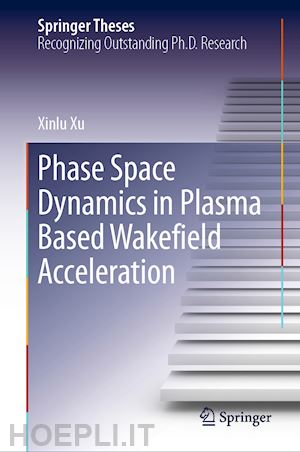
Questo prodotto usufruisce delle SPEDIZIONI GRATIS
selezionando l'opzione Corriere Veloce in fase di ordine.
Pagabile anche con Carta della cultura giovani e del merito, 18App Bonus Cultura e Carta del Docente
This book explores several key issues in beam phase space dynamics in plasma-based wakefield accelerators. It reveals the phase space dynamics of ionization-based injection methods by identifying two key phase mixing processes. Subsequently, the book proposes a two-color laser ionization injection scheme for generating high-quality beams, and assesses it using particle-in-cell (PIC) simulations. To eliminate emittance growth when the beam propagates between plasma accelerators and traditional accelerator components, a method using longitudinally tailored plasma structures as phase space matching components is proposed. Based on the aspects above, a preliminary design study on X-ray free-electron lasers driven by plasma accelerators is presented. Lastly, an important type of numerical noise—the numerical Cherenkov instabilities in particle-in-cell codes—is systematically studied.
Chapter 1 Introduction
1.1 Introduction
1.2 Plasma Based Acceleration
1.3 Particle-in-Cell Simulations
1.4 Motivation and Outline
Chapter 2 Phase Space Dynamics of Injected Electron Beams in Ionization Injection
2.1 Introduction
2.2 The Photoionization Process
2.3 The Residual Momentum
2.3.1 Initial Momentum from the Tunneling Ionization
2.3.2 The Momentum from the Lasers: Longitudinal Injection
2.3.3 The Momentum from the Lasers: Transverse Injection
2.3.4 The Thermal Emittance
2.4 Single Particle Motion in the Nonlinear Wake
2.5 Transverse Phase Mixing
2.5.1 Emittance Evolution: Growth and Oscillation in the Injection Stage
2.5.2 Emittance Evolution: Decrease and Regrowth in the Acceleration Stage
2.5.3 A Phenomenological Model
2.5.4 Comparisons with PIC Simulations
2.6 Longitudinal Phase Mixing
2.6.1 The Trapping Condition
2.6.2 Longitudinal Phase Mixing
2.7 Space Charge Effects
2.8 The Two-Color Ionization Injection
2.8.1 The Emittance in A Single Laser Case
2.8.2 The Two-Color Ionization Injection: Longitudinal Injection
2.8.3 The Two-Color Ionization Injection: Transverse Injection
2.9 Intrinsic Phase Space Discretization in Laser Triggered Ionization Injection
2.9.1 Single Laser Pulse Case
2.9.2 Beam Driver with a Laser Injector
2.10 Summary
3.1 Introduction
3.2 The Emittance Growth between Stages
3.2.1 Emittance Growth in Free Space Drifting
3.2.2 Emittance Growth in A Uniform Focusing Field
3.3 Theoretical Analysis of A Matching Plasma
3.3.1 How to Design the Matching Plasma?
3.3.2 The Effect of the Energy Spread
3.4 Verification by PIC Simulations
3.4.1 Matching Between Two-Stage LWFAs
3.4.2 Matching in External Injection
3.4.3 Matching between LWFAs and the Quadrupoles
Chapter 4 X-FELs Driven by Plasma Based Accelerators
4.1 Introduction
4.1.2 The Challenges and Opportunities of X-FELs Driven by plasma Based Accelerators
4.2 X-FEL Driven by A Two-Stage LWFA
4.2.2 Simulation of the Accelerator Stage
4.2.3 Simulation of the Undulator Stage
4.3 Conclusions
Chapter 5 Numerical Instability due to Relativistic Plasma Drift in EM-PIC Simulations
5.1 Introduction
5.1.1 The Boosted Frame Simulations of LWFA
5.1.2 Numerical Noise Induced by Relativistic Plasma Drift in PIC Codes
5.2 Numerical Dispersion Relation for Cold Plasma Drift
5.2.1 Derivation of Dispersion Relation
5.2.2 Elements of Dispersion Relation Tensor
5.2.3 EM Modes, and Wave-Particle Resonance
5.3 Numerical Instability Induced by Relativistic Plasma Drift for the Yee Solver
5.3.1 Theoretical Analysis of the 2D Dispersion Relation
5.3.2 Simulation Study of the Instability
5.4 Asymptotic Expression for Instability Growth Rate
5.4.1 Derivation of Asymptotic Expression
5.4 2 Parameter Scans for Minimal Instability Growth Rate
5.5 Elimination of the Numerical Cerenkov Instability for Spectral EM-PIC codes
5.5.1 The NCI Modes For the Spectral Solver
5.5.2 The Positions and the Growth Rates of the NCI Modes for the Spectral Solver
5.53 LWFA Simulation in the Lorentz Boosted Frame with Spectral Solver
5.6 Conclusions
Chapter 6 Summary
6.1 Concluding Remarks
6.2 Future Work
Reference
Acknowledgement
Appendix A
A.1 Derivation of the Emittance Evolution in the Acceleration Stage
A.2 Interpolation Tensor and Finite Difference Operator











Il sito utilizza cookie ed altri strumenti di tracciamento che raccolgono informazioni dal dispositivo dell’utente. Oltre ai cookie tecnici ed analitici aggregati, strettamente necessari per il funzionamento di questo sito web, previo consenso dell’utente possono essere installati cookie di profilazione e marketing e cookie dei social media. Cliccando su “Accetto tutti i cookie” saranno attivate tutte le categorie di cookie. Per accettare solo deterninate categorie di cookie, cliccare invece su “Impostazioni cookie”. Chiudendo il banner o continuando a navigare saranno installati solo cookie tecnici. Per maggiori dettagli, consultare la Cookie Policy.